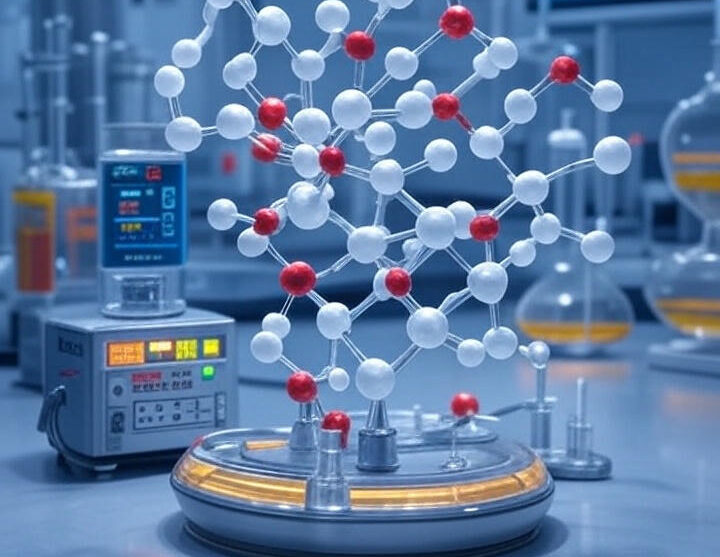Water, scientifically known as H₂O, is one of the most essential and abundant resources on Earth, covering 71% of the planet’s surface. It is vital for the survival of all living organisms and plays a crucial role in maintaining ecological balance, supporting economic development, and sustaining human health. Despite its abundance, only 2.5% of Earth’s water is freshwater, and less than 1% is accessible for human use. Renowned hydrologist John C. Rodda, in his research on global water resources, stated,
“Water is the bloodstream of the biosphere,” emphasizing its critical role in supporting life and ecosystems.
Chemical Composition and Structure of Water
Water is a covalent molecule, consisting of two hydrogen atoms bonded to one oxygen atom (H₂O) at an angle of 104.5 degrees, forming a polar molecule. This polarity allows water to dissolve a wide range of substances, earning it the title of the “universal solvent.”
Scientific Contribution:
Linus Pauling, a Nobel Prize-winning chemist, extensively studied the hydrogen bonding in water molecules, which explains water’s unique properties such as high surface tension, cohesion, and adhesion. like Water’s ability to dissolve nutrients allows plants to absorb minerals from the soil and transport them through their roots to support growth and photosynthesis.
Sources of Water on Earth
Water exists in different forms and reservoirs:
1. Surface Water: Rivers, lakes, oceans, and reservoirs. 2. Groundwater: Stored in underground aquifers. 3. Atmospheric Water: Water vapor and clouds. 4. Glaciers and Ice Caps: Frozen freshwater in polar regions and mountains.
Scientific Contribution: Dr. Luna Leopold, an American hydrologist, conducted extensive research on river hydrology and surface water flow, which helped in understanding the movement and distribution of water on Earth’s surface. Example: The Amazon River Basin, which holds 20% of the world’s freshwater, is a major source of water for South American biodiversity and agriculture.
Importance of Water in Different Spheres

1. Biological Importance Water is essential for cellular metabolism, transportation of nutrients, and temperature regulation in living organisms. Scientific Discovery : Dr. Peter Agre, a Nobel laureate, discovered aquaporins, the water channels in cell membranes that regulate the movement of water in and out of cells. Example: In humans, water makes up 60-70% of body weight and is essential for digestion, blood circulation, and waste elimination.
2. Environmental Importance Water is crucial for maintaining biodiversity, climate regulation, and ecosystem stability. Research Contribution: Dr. Wallace S. Broecker, an American climate scientist, studied the thermohaline circulation, also known as the “Global Conveyor Belt“, which regulates heat distribution in the oceans and stabilizes the Earth’s climate. Example: The Coral Reef Ecosystem in the Great Barrier Reef depends on warm ocean currents for nutrient exchange and marine biodiversity.

3. Economic and Industrial Importance-Water is essential for agriculture, industrial processes, energy production, and transportation. Research Findings: Dr. Sandra Postel, a global water expert, focused on sustainable water management and the impact of water scarcity on global economies. Example: The Indus River Basin supports the agriculture of Pakistan and India, irrigating over 26 million hectares of farmland.
4. Social and Cultural Importance -Water holds significant cultural, religious, and social importance in human civilization. Historical Perspective: Dr. Garrett Hardin, an ecologist, introduced the concept of “The Tragedy of the Commons”, which explains how the overuse of shared water resources leads to depletion and scarcity. Example: The Ganges River in India is considered sacred in Hindu culture and is used for religious ceremonies and purification rituals.
Water Cycle (Hydrological Cycle)– The Water Cycle is a continuous process through which water circulates between the atmosphere, land, and oceans. Stages of the Water Cycle:1. Evaporation: Sun’s heat turns water from oceans and lakes into vapor. 2. Condensation: Water vapor cools and forms clouds. 3. Precipitation: Water falls back to Earth as rain, snow, or hail. 4. Infiltration and Runoff: Water seeps into the ground or flows back to water bodies.
Scientific Contribution: Dr. Robert E. Horton, an American hydrologist, developed the Horton Infiltration Theory, explaining how water moves through soil layers and recharges groundwater.
Water Scarcity and Global Crisis ::
Despite the abundance of water on Earth, 2 billion people lack access to clean drinking water, as reported by the World Health Organization (WHO). Causes of Water Scarcity: 1. Climate Change 2. Overpopulation 3. Industrial Pollution 4. Deforestation and Soil Erosion
Scientific Contribution: Dr. Rajendra Singh, known as the “Water Man of India”, revived ancient rainwater harvesting techniques to restore groundwater levels in drought-affected regions of India. Example: Countries like Israel have successfully implemented desalination technology to convert seawater into freshwater for drinking and agriculture.
Water Conservation and Sustainable Management ::–

Effective Solutions: 1. Rainwater Harvesting 2. Wastewater Recycling 3. Drip Irrigation in Agriculture 4. Protection of Wetlands and Forests
Global Initiatives: The United Nations’ Sustainable Development Goal (SDG-6) aims for “Clean Water and Sanitation for All” by 2030.
Water is not just a basic necessity; it is the foundation of life, environment, and economy. From scientific research to cultural significance, water remains a vital resource for the survival of the planet. However, increasing water pollution, climate change, and over-extraction of freshwater resources pose severe threats to future generations. Sustainable water management practices and global cooperation are essential to preserve this invaluable resource for the future. . Some References 1. Dr. Peter Agre – Nobel Prize in Chemistry, 2003 (Discovery of Aquaporins) 2. Dr. Wallace Broecker – Climate Change and Ocean Circulation 3. Dr. Luna Leopold – River Hydrology Research 4. Dr. Rajendra Singh – Water Conservation in India















